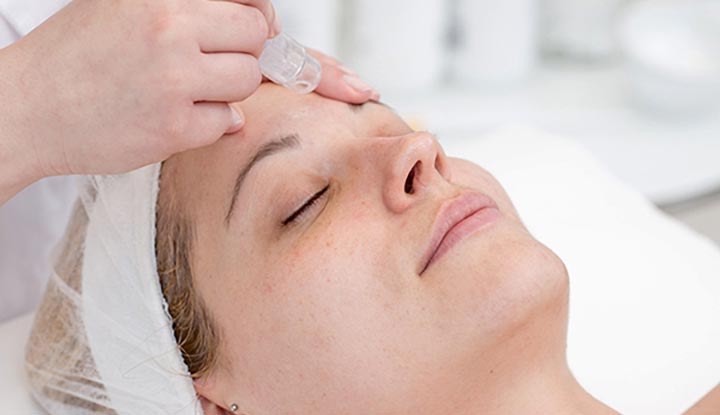Microdermabrasion is a minimally invasive procedure to remove the uppermost layer of skin from your face or body. It can help improve the appearance of your skin and minimize wrinkles, age spots or other minor cosmetic concerns.
Advertisement
Cleveland Clinic is a non-profit academic medical center. Advertising on our site helps support our mission. We do not endorse non-Cleveland Clinic products or services. Policy

Microdermabrasion is a minimally invasive cosmetic procedure for your skin. A dermatologist provider uses a special instrument to gently exfoliate (sand away) the uppermost layer of your skin. You can get microdermabrasion on your face, neck, back, hands or chest.
Advertisement
Cleveland Clinic is a non-profit academic medical center. Advertising on our site helps support our mission. We do not endorse non-Cleveland Clinic products or services. Policy
Microdermabrasion:
Microdermabrasion removes the uppermost layer of skin. This can improve the look and feel of your skin, revealing smoother, more youthful-looking skin. Microdermabrasion can make the following skin conditions less noticeable:
Microdermabrasion is a safe cosmetic procedure and doesn’t have serious risks. But some people may notice:
Microdermabrasion might not be right for everyone. Talk to your healthcare provider before getting this procedure if you have:
Advertisement
Microdermabrasion is a common treatment. It’s often among the top five most common nonsurgical cosmetic procedures.
Before your microdermabrasion procedure, you’ll consult with a healthcare provider. A plastic surgeon, dermatologist or cosmetologist/aesthetician can perform microdermabrasion. They’ll go over your health history and your goals for the procedure. They may also take before photos of the area of skin that will have treatment.
This is a good time to ask any questions you may have about the procedure, like:
You don’t need topical or local anesthetic to numb your skin before microdermabrasion. The procedure usually isn’t painful, but you might feel a scratching, stinging, sucking or vibrating sensation on your skin.
Your healthcare provider uses one of two techniques to remove dead or damaged cells in microdermabrasion:
Treatment usually lasts about 30 to 40 minutes.
You can go home right after your procedure. Your skin might be a little red, swollen or sensitive for up to 24 hours. Your healthcare provider may provide a cream for your skin, which can calm the irritation.
Most people get between one and four treatments each month to achieve their desired results. Monthly treatments after that can help you maintain the results.
Microdermabrasion results vary from person to person. Your skin will feel softer and smoother after your first treatment. But the results of microdermabrasion build up over time. Most people need multiple treatments to achieve their desired cosmetic goals.
Microdermabrasion is one good way to improve the look of your skin. But microdermabrasion doesn’t stop your skin cells from aging and dying. Your healthcare provider will evaluate how well you heal after your first treatment to determine how soon you can have your next treatment. After you reach your desired results, talk with your healthcare provider about how often they think you’ll need to repeat the treatment to keep the results.
Contact your healthcare provider if you notice the treated area is:
Advertisement
You may want to ask your healthcare provider:
Both microdermabrasion and chemical peels exfoliate and brighten your skin. The difference is about how they do it.
Microdermabrasion is a physical exfoliator — it removes skin by rubbing it off. It only removes the top layer of skin. So, the dull skin comes off and your face feels smoother.
As the name implies, a chemical peel is a type of facial that uses chemicals to exfoliate deeper than microdermabrasion allows.
Dermabrasion is more aggressive than microdermabrasion. Your dermatologist may recommend dermabrasion over microdermabrasion if you’re worried about deep scars and wrinkles. Your dermatologist may also recommend it to remove certain pre-cancerous growths.
While microdermabrasion doesn’t cause bleeding, dermabrasion does. So, you’ll need a bit more recovery time after dermabrasion.
These days, you might feel like everyone is getting something done to their skin to look younger. But it’s important to remember that aging is a natural process. You are beautiful just as you are.
Advertisement
That said, sometimes, having smooth, healthy-looking skin can give us a boost of confidence as we age. If that’s what you’re looking for, microdermabrasion may be a good option for you. It’s a minimally invasive way to exfoliate dead or damaged skin cells. It can reveal smoother, brighter skin and reduce the appearance of fine lines, age spots or light scars. You’ll likely need multiple treatments. If you have very sensitive skin or chronic skin conditions, talk to your dermatologist before getting microdermabrasion.
Advertisement
Every day, people see your skin, hair and nails. At Cleveland Clinic, our expert and caring dermatology team will make sure they’re healthy and strong.

Last reviewed on 07/12/2023.
Learn more about the Health Library and our editorial process.